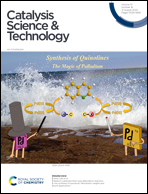Insight into the effects of electronegativity on the H2 catalytic activation for CO2 hydrogenation: four transition metal cases from a DFT study†
Abstract
The choice of CO2 hydrogenation for improving product selectivity is closely related to the type of active H species on the catalyst surface. Herein, we report a density functional theory (DFT) study on H2 activation and CO2 pre-hydrogenation over four transition metal surfaces, i.e., Fe(111), Ni(111), Ru(0001) and Pt(111), to reveal the effect of metal electronegativity on the path choice of CO2 hydrogenation. Metal electronegativity dominates the type of active H species on transition metal surfaces. Negative H− (1s2) from H2 dissociation on Fe(111) prefers to combine with the C-site of CO2 benefiting for the C-terminal hydrogenation, and positive H+ (1s0) from H2 dissociation on Pt(111) prefers to combine with the O-site of CO2 benefiting for the O-terminal hydrogenation. The selective hydrogenation on Ni(111) and Ru(0001) are affected by CO2 activation due to their close electronegativity to that of H. This study reveals the effect of electronegativity on the selective hydrogenation of CO2, which is helpful to design new catalysts for the hydrogenation of CO2 to value-added chemicals.



 Please wait while we load your content...
Please wait while we load your content...